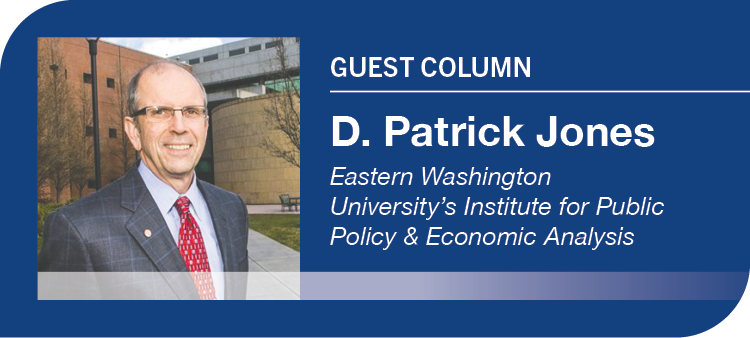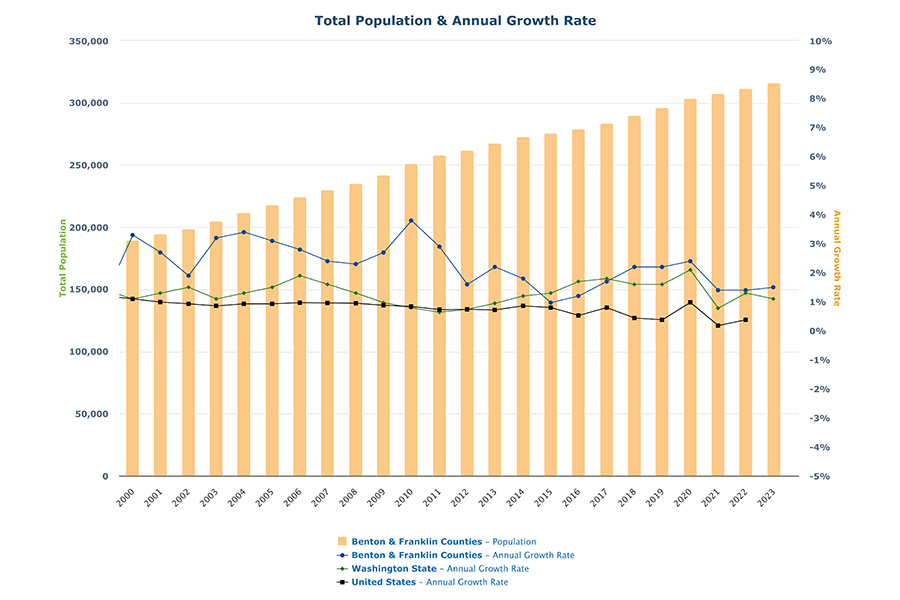
Home » Tri-Cities posts another strong year of population growth — with considerable variation
Tri-Cities posts another strong year of population growth — with considerable variation

August 14, 2023
Covering the population beat for the greater Tri-Cities is getting monotonous.
Benton and Franklin counties, as previously reported in the Tri-Cities Area Journal of Business, continue to outperform most counties of the state.
Recently released estimates from the demographers at the Washington Office of Financial Management (OFM) put the two-county total estimate for April 1 at nearly 317,000, a gain of nearly 5,000 compared to last year.
As seen in Benton-Franklin Trends data, the growth rate for the two counties was about 1.5%.
For Washington state the rate was 1.1%.
This marked the 20th year since the start of the millennium that the population here has grown faster than the average rate of the state. This is a remarkable run.
Both counties grew at approximately the same pace, a phenomenon observed since 2014. Before that, Franklin County was outpacing Benton County. Compared to all 39 counties in the state, year-over-year growth in Benton placed it second, after Whatcom County. Franklin County ranked fifth, after Snohomish and Grant counties.
Beneath overall rates lurks significant variation.
Of the three largest cities in the metro area, Richland grew the fastest over the past 12 months, at an estimated rate of 1.8%. But it was the two smaller cities in Benton County that won the growth sweepstakes. Prosser’s estimated head count grew by 4%, while West Richland’s numbers climbed an estimated 2.4%.
As has been the case here and most places in the U.S., net migration provided greater numbers to the head count than the natural increase, or births minus deaths.

A comparison of Trends data and residual net migration shows out of the approximate increase of nearly 5,000 people, about 3,200 are new arrivals in the metro area. This means about 70% of the gain in the two counties came courtesy of “outsiders.”
This share is actually low for most Eastern Washington metro areas. In Walla Walla, it was 100%. In-migration in that county was larger than the population increase, as the natural increase was negative. In the greater Wenatchee area, in-migration made up 93% of last year’s population gain. In Spokane, 89%.
But this relatively low share in the metro area masks a considerable difference between the counties. Net in-migration in Benton County amounted to 86% of its population gain; in contrast, in Franklin County it was a mere 33%.
The low rate in Franklin County stems from both Benton County attracting more newcomers and from a higher fertility rate on the east side of the Columbia River.
For 2020, Franklin’s rate was 7.5 births per 100 women age 15-44 versus 6.7 per 100 for Benton. Franklin County’s fertility rate was exceeded only by Grant and Yakima in the entire state.
Unlike many metro areas then, population growth here is more balanced between a natural increase and in-migration.
Where do the new residents hail from? Thanks to the Census program, “County to County Migration Patterns,” we have a good idea, based on the period 2016-20, the most recent available.
On a net basis, it likely comes as no surprise that the state contributing the most has been California, by a wide margin. In second place has been Oregon, and in third, Utah.
It might surprise some that the Census data show the greater Tri-Cities to be a net exporter of people to the rest of Washington state.
In other words, while people may move to the area from the other 37 counties, on balance, more Tri-Citians move away.
The county destinations with the highest numbers of former local residents on a net basis has been King, followed by Spokane, Chelan, Adams and Grant counties. Washington counties that have recently contributed the most to net in-migration here are Clark, Douglas and Walla Walla.
It might surprise even more to learn that a large proportion of the net in-migrants come from distant shores.
Census data does not break out specific countries, but it tracks regions. The largest contributing region recently has been Europe, followed by Asia and then Central America. The sum of international migrants has actually been larger than the total of all domestic net migration to the two counties. The greater Tri-Cities is becoming international!
Forecasts by OFM predict robust growth through the end of the decade.
By 2030, its demographers, via their “middle” projections, anticipate a two-county total of 350,000, or a gain of 33,000 from this spring. Those increases likely will come the same combination observed now: relatively strong natality, some domestic net in-migration and robust international migration.
Let the games begin over where new Tri-Citians will live.
Patrick Jones is the executive director for Eastern Washington University’s Institute for Public Policy & Economic Analysis. Benton-Franklin Trends, the institute’s project, uses local, state and federal data to measure the local economic, educational and civic life of Benton and Franklin counties.
Opinion
KEYWORDS august 2023





